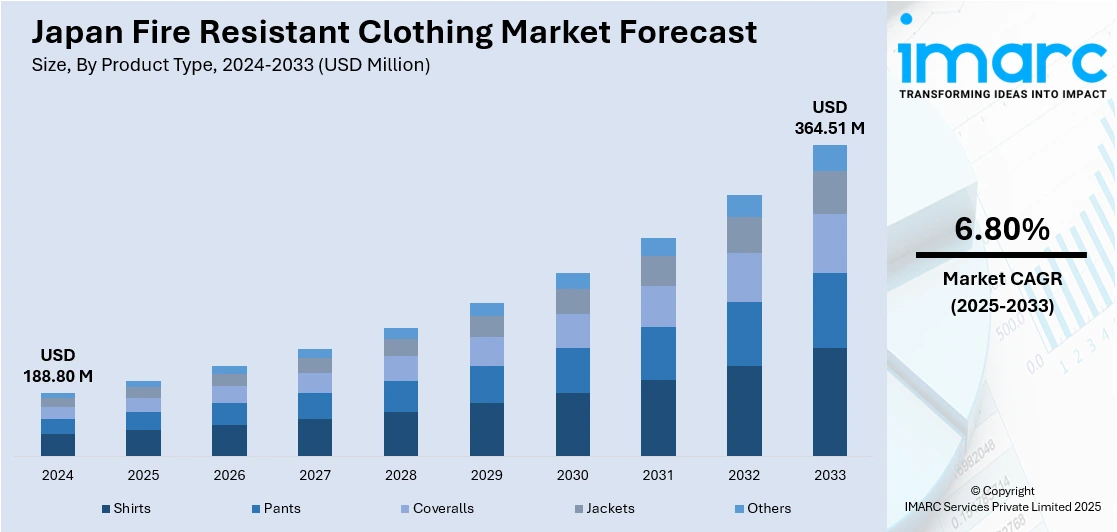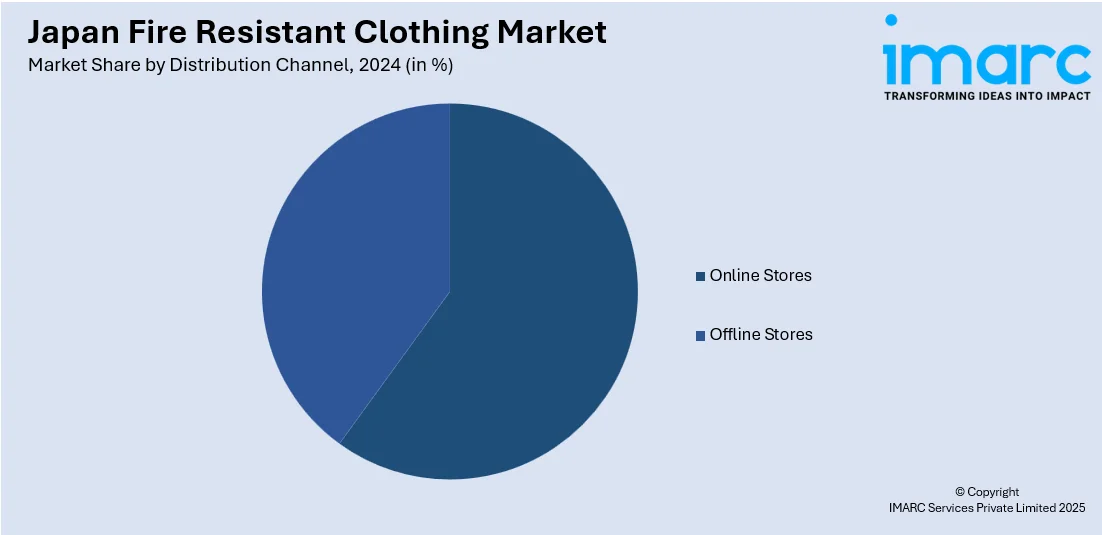
Japan Fire Resistant Clothing Market Size, Share, Trends and Forecast by Product Type, Material Type, Distribution Channel, Application, End User, and Region, 2025-2033
Japan Fire Resistant Clothing Market Overview:
The Japan fire resistant clothing market size reached USD 188.80 Million in 2024. Looking forward, IMARC Group expects the market to reach USD 364.51 Million by 2033, exhibiting a growth rate (CAGR) of 6.80% during 2025-2033. The market is driven by growing industrial safety regulations, increasing awareness of workplace hazards, and a rise in high-risk occupations such as manufacturing, energy, and construction. The Japan fire resistant clothing market share is also fueled by advancements in fabric technology, offering greater comfort and performance. Additionally, Japan’s aging workforce emphasizes ergonomic, protective gear, while sustainability concerns push manufacturers to innovate with eco-friendly materials.
|
Report Attribute
|
Key Statistics
|
|---|---|
|
Base Year
|
2024
|
|
Forecast Years
|
2025-2033
|
|
Historical Years
|
2019-2024
|
| Market Size in 2024 | USD 188.80 Million |
| Market Forecast in 2033 | USD 364.51 Million |
| Market Growth Rate 2025-2033 | 6.80% |
Japan Fire Resistant Clothing Market Trends:
Technological Innovation in Fabrics
Japan's flame-resistant clothing industry is changing rapidly, supported by innovative fabric technologies to enhance safety as well as wearability. Companies are creating sophisticated materials that extend beyond mere flame resistance and incorporate aspects such as self-extinguishing properties and temperature regulation. These advancements make clothing not only safer to wear but also more comfortable for prolonged periods in harsh conditions. Increased breathability, flexibility, and durability are taking center stage to allow high-risk workers to carry out their work with minimal inconvenience or hindrance. The transition is in response to increased demand for protective garments that are up to the standards of contemporary expectations in terms of performance, mobility, and sustainability. The move towards user-savvy design and intelligent material science is a major improvement in occupational safety. Through the combination of protection and comfort, these advancements in technology are turning fire-resistant clothing from a necessity for safety into a performance aid for physically demanding and risky environments' workers.

Growth Beyond Traditional Industries
Fire-resistant clothing is gaining popularity in Japan beyond their conventional high-risk industries such as oil, gas, and construction. Healthcare, transportation, and food processing industries are also embracing this protective wear to improve workplace safety. Although not generally considered risky for fires, these industries understand the value of avoiding sudden occurrences, e.g., electrical fires or spark-related fires from equipment. This change is driven in large part by increasing awareness and regulation of occupational health and safety. Businesses are assuming a proactive role in managing risk by providing protective gear for workers, even in less straightforward settings. This development reflects a wider cultural emphasis in Japan on worker welfare in all sectors. As more flexible and comfortable fire-resistant clothing becomes available, its use is expanding, setting it up as a standard component of contemporary workplace safety measures across a wide variety of industries.
Emphasis on Sustainability
Sustainability is playing a growing role in shaping Japan’s fire-resistant clothing market growth. Manufacturers are now prioritizing the development of eco-friendly materials that balance safety with environmental responsibility. This includes the use of recyclable or biodegradable fabrics and reducing reliance on harmful flame-retardant chemicals. Traditional fire-resistant treatments often involve substances that can negatively impact ecosystems during production or disposal. By adopting greener alternatives, companies aim to minimize their environmental footprint while still meeting strict safety standards. This trend reflects a wider shift in both industrial practices and consumer expectations, where environmental ethics and product transparency are increasingly valued. Businesses and workers are also more inclined to choose protective gear that supports sustainability goals without compromising performance. In this way, eco-conscious fire-resistant clothing not only fulfills regulatory and functional demands but also strengthens brand credibility in a market where environmental responsibility is becoming a key purchasing factor.
Japan Fire Resistant Clothing Market Segmentation:
IMARC Group provides an analysis of the key trends in each segment of the market, along with forecasts at the country and regional levels for 2025-2033. Our report has categorized the market based on product type, material type, distribution channel, application and end user.
Product Type Insights:
- Shirts
- Pants
- Coveralls
- Jackets
- Others
A detailed breakup and analysis of the market based on the product type have also been provided in the report. This includes shirts, pants, coveralls, jackets, and others.
Material Type Insights:
- Treated FR Fabric
- Inherent FR Fabric
The report has provided a detailed breakup and analysis of the market based on the material type. This includes treated FR fabric and inherent FR fabric.
Distribution Channel Insights:

- Online Stores
- Offline Stores
A detailed breakup and analysis of the market based on the distribution channel have also been provided in the report. This includes online stores and offline stores.
Application Insights:
- Oil and Gas
- Construction
- Manufacturing
- Mining
- Military
- Others
The report has provided a detailed breakup and analysis of the market based on the application. This includes oil and gas, construction, manufacturing, mining, military, and others.
End User Insights:
- Industrial
- Commercial
- Residential
A detailed breakup and analysis of the market based on the end user have also been provided in the report. This includes industrial, commercial, and residential.
Regional Insights:
- Kanto Region
- Kansai/Kinki Region
- Central/ Chubu Region
- Kyushu-Okinawa Region
- Tohoku Region
- Chugoku Region
- Hokkaido Region
- Shikoku Region
The report has also provided a comprehensive analysis of all the major regional markets, which include Kanto Region, Kansai/Kinki Region, Central/ Chubu Region, Kyushu-Okinawa Region, Tohoku Region, Chugoku Region, Hokkaido Region, and Shikoku Region.
Competitive Landscape:
The market research report has also provided a comprehensive analysis of the competitive landscape. Competitive analysis such as market structure, key player positioning, top winning strategies, competitive dashboard, and company evaluation quadrant has been covered in the report. Also, detailed profiles of all major companies have been provided.
Japan Fire Resistant Clothing Market News:
- In September 2024, Asahi Kasei launched a new grade of Lastan, a flame-retardant, flexible nonwoven fabric designed to enhance EV battery safety. Offering high flame resistance, electrical insulation up to 3.5 kV, and superior processability, Lastan outperforms conventional mineral-based materials. Ideal for battery pack components, it resists high temperatures and particle impact. The company plans to expand production globally and will showcase Lastan at the North American Battery Show in October 2024.
Japan Fire Resistant Clothing Market Report Coverage:
| Report Features | Details |
|---|---|
| Base Year of the Analysis | 2024 |
| Historical Period | 2019-2024 |
| Forecast Period | 2025-2033 |
| Units | Million USD |
| Scope of the Report |
Exploration of Historical Trends and Market Outlook, Industry Catalysts and Challenges, Segment-Wise Historical and Future Market Assessment:
|
| Product Types Covered | Shirts, Pants, Coveralls, Jackets, Others |
| Material Types Covered | Treated FR Fabric, Inherent FR Fabric |
| Distribution Channels Covered | Online Stores, Offline Stores |
| Applications Covered | Oil And Gas, Construction, Manufacturing, Mining, Military, Others |
| End Users Covered | Industrial, Commercial, Residential |
| Regions Covered | Kanto Region, Kansai/Kinki Region, Central/ Chubu Region, Kyushu-Okinawa Region, Tohoku Region, Chugoku Region, Hokkaido Region, and Shikoku Region |
| Customization Scope | 10% Free Customization |
| Post-Sale Analyst Support | 10-12 Weeks |
| Delivery Format | PDF and Excel through Email (We can also provide the editable version of the report in PPT/Word format on special request) |
Key Questions Answered in This Report:
- How has the Japan fire resistant clothing market performed so far and how will it perform in the coming years?
- What is the breakup of the Japan fire resistant clothing market on the basis of product type?
- What is the breakup of the Japan fire resistant clothing market on the basis of material type?
- What is the breakup of the Japan fire resistant clothing market on the basis of distribution channel?
- What is the breakup of the Japan fire resistant clothing market on the basis of application?
- What is the breakup of the Japan fire resistant clothing market on the basis of end user?
- What is the breakup of the Japan fire resistant clothing market on the basis of region?
- What are the various stages in the value chain of the Japan fire resistant clothing market?
- What are the key driving factors and challenges in the Japan fire resistant clothing market?
- What is the structure of the Japan fire resistant clothing market and who are the key players?
- What is the degree of competition in the Japan fire resistant clothing market?
Key Benefits for Stakeholders:
- IMARC’s industry report offers a comprehensive quantitative analysis of various market segments, historical and current market trends, market forecasts, and dynamics of the Japan fire resistant clothing market from 2019-2033.
- The research report provides the latest information on the market drivers, challenges, and opportunities in the Japan fire resistant clothing market.
- Porter's five forces analysis assist stakeholders in assessing the impact of new entrants, competitive rivalry, supplier power, buyer power, and the threat of substitution. It helps stakeholders to analyze the level of competition within the Japan fire resistant clothing industry and its attractiveness.
- Competitive landscape allows stakeholders to understand their competitive environment and provides an insight into the current positions of key players in the market.
Need more help?
- Speak to our experienced analysts for insights on the current market scenarios.
- Include additional segments and countries to customize the report as per your requirement.
- Gain an unparalleled competitive advantage in your domain by understanding how to utilize the report and positively impacting your operations and revenue.
- For further assistance, please connect with our analysts.
 Request Customization
Request Customization
 Speak to an Analyst
Speak to an Analyst
 Request Brochure
Request Brochure
 Inquire Before Buying
Inquire Before Buying




.webp)




.webp)












